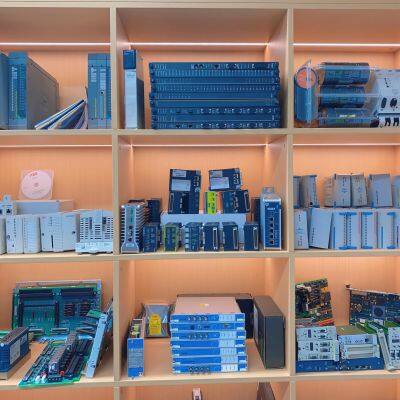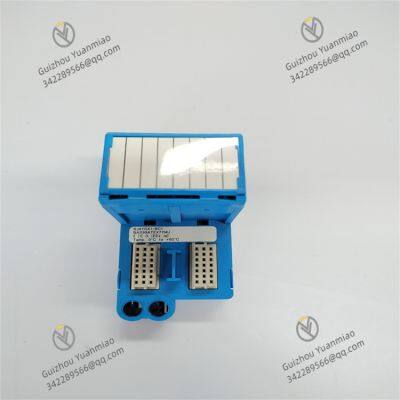Product Description
I. Overview
KJ4110X1 - BC1 is a high-performance digital input/output hybrid module in Emerson's DeltaV Distributed Control System (DCS). It integrates both digital signal acquisition and digital signal output functions, enabling simultaneous monitoring of on-site digital quantity status and control of digital executive equipment. It is an important component of the DeltaV system for realizing the integration of discrete control and status monitoring.
In the process of industrial automation control, the operating status of a large number of equipment (such as whether a motor is running, the opening/closing status of a valve, etc.) needs to be monitored in real time, and various solenoid valves, contactors, etc. need to be controlled by switching. The KJ4110X1 - BC1 module perfectly adapts to this control demand. It can efficiently cooperate with the DeltaV control system to provide a solid guarantee for the stable operation of the production process. For example, in the control of welding stations in automobile production lines, the module, on the one hand, collects digital information such as the working status of welding robots and workpiece in-place signals and transmits them to the DeltaV control system; on the other hand, it receives instructions from the control system and outputs digital signals to control the clamping and releasing of welding fixtures, the on/off of welding power supplies, etc., ensuring the orderly progress of the welding process.

II. Technical Parameters
(1) Electrical Parameters
Power supply voltage: 24V DC power supply is adopted, which conforms to the power supply standards of most automation equipment in industrial sites, facilitating the unified planning and configuration of the system power supply. The module has strong power anti-fluctuation capability, and can work stably within the voltage fluctuation range of 24V DC±15%, ensuring the reliability of signal acquisition and output.
Input signal parameters: It supports two digital input forms: dry contacts and wet contacts. Dry contact input does not require an external power supply and is suitable for connecting mechanical contact equipment; wet contact input requires an external 24V DC power supply and can be directly connected to active equipment such as photoelectric sensors and proximity switches. The response voltage range of the input signal is 15 - 30V DC, ensuring accurate identification of effective signals.
Output signal parameters: It is in the form of relay output. Each output channel can provide a normally open contact, with a rated load of 250V AC/5A and 30V DC/5A, which can directly drive small motors, solenoid valves, intermediate relays and other equipment without additional power amplifying devices, simplifying the system design.
Power consumption: The power consumption during normal operation is low, usually not exceeding 8W, which will not bring excessive pressure to the system power supply. At the same time, it reduces the heat generation of the module, helping to extend its service life.
(2) Performance Parameters
Channel configuration: It includes 16 digital input channels and 8 digital output channels. This combination of channel quantities is suitable for industrial scenarios that need to monitor more status signals and control an appropriate number of executive equipment, which can meet the needs of small and medium-sized control loops and improve the integration of the system.
Response time: The response time of the digital input channel is less than 1ms, which can quickly capture the status changes of on-site equipment; the response time of the digital output channel is less than 5ms, which can timely transmit control instructions to executive equipment, ensuring the real-time performance of control and performing excellently in occasions with high requirements for response speed.

Isolation performance: Photoelectric isolation technology is adopted between input channels and output channels, and between each channel and the internal circuit of the module. The isolation voltage reaches 2500V AC, which can effectively prevent on-site strong electrical interference and ground potential difference from affecting the module and the control system, improving the anti-interference ability of the system.
Output contact life: The mechanical life of the relay output contact can reach more than 1 million times, and the electrical life under rated load exceeds 100,000 times, which can meet the needs of long-term frequent operations, reducing the replacement frequency and maintenance cost of the module.
(3) Physical and Environmental Parameters
Protection level: The shell protection level is IP20, which is suitable for the environment installed inside the control cabinet. It can prevent solid foreign objects with a diameter greater than 12mm from entering the module and protect internal circuit components. The inside of the module adopts a multiple electromagnetic shielding design, which can effectively resist electromagnetic interference and radio frequency interference in the industrial environment, ensuring the stability of signal transmission.
Working environment conditions: The working temperature range is -40°C to 70°C, which can work normally in extreme temperature environments such as severe cold and high temperature; the relative humidity is 5% - 95% (no condensation), which can adapt to humid industrial places such as textile factories and food processing factories. In addition, the module can withstand certain vibration and impact, and can still maintain a stable working state under the conditions of vibration frequency 10 - 500Hz, acceleration 5g and impact acceleration 15g.
Size and weight: The external dimensions of the module are 125mm in length × 100mm in width × 40mm in height, and the weight is about 350g. It has a compact structure, occupies little space in the control cabinet, and is convenient for installation and layout.
Installation method: It adopts 35mm standard DIN rail installation. The installation process is simple and fast, without special tools. It can be fixed by simply clamping the module into the rail, which improves the efficiency of system installation and maintenance.

III. Functional Features
(1) Hybrid Control, Efficient Integration
Input-output integrated design: The functions of digital input and output are integrated into one module, reducing the number of modules in the system, simplifying system wiring and control cabinet layout, and reducing the complexity and cost of the system. At the same time, the close-distance design of input and output channels shortens the signal transmission path and improves the control response speed.
Seamless integration with DeltaV system: As a dedicated module for the DeltaV system, it can achieve in-depth collaboration with the system's controllers, configuration software, etc. During system configuration, module parameter configuration and channel mapping can be quickly completed through DeltaV software; during operation, data exchange between the module and the controller is efficient and smooth, ensuring timely upload of on-site status information and rapid issuance of control instructions.
(2) Reliable Signal Processing and Control
Accurate digital signal acquisition: The digital input channel adopts a high-sensitivity photoelectric coupler and filter circuit, which can accurately identify on-site digital signals, effectively suppress spike pulses and electromagnetic interference, and avoid misjudgment. For example, when monitoring the workpiece in-place signal of the assembly line, even if there is interference from motor start-stop on site, the module can accurately capture the real in-place signal.
Stable output control: The relay contacts of the digital output channel have good conductivity and stability, and can reliably connect and disconnect the load circuit. The module also has an output short-circuit protection function. When a short circuit occurs in the output channel, it will quickly cut off the output to protect the relay and the module from damage, and the output can be automatically restored after the fault is eliminated.
(3) Comprehensive Diagnosis and Protection
Channel status diagnosis: Each input and output channel has an independent status diagnosis function, which can monitor the signal status and working conditions of the channel in real time. When the input channel is disconnected or short-circuited, or the output channel relay fails, the module will timely upload the fault information to the DeltaV control system and send an alarm signal through the system, facilitating operators to quickly locate and eliminate the fault.
Module self-diagnosis: The module has a perfect self-diagnosis function, which can monitor its own power supply status and internal circuit working status in real time. When the module has problems such as abnormal power supply and internal chip failure, it will immediately trigger an alarm to remind maintenance personnel to handle it in time, improving the maintainability and reliability of the system.


Emerson VE4003S2B1 Standard I/O Termination Block
Emerson VE4003S3B1 Standard I/O Termination Block
Emerson VE4003S5B1 Standard I/O Termination Block
Emerson VE4005S1B3 DeltaV S-series Traditional I/O
Emerson VE4005S2B1 DeltaV S-series Traditional I/O
Praxis 98.6.030.702 DIN-I/O Module
Praxis 98.6.032.702 I/O Module
Praxis 98.6.034.702 DIN-I/O Module
Praxis 98.6.034.800 Digital I/O Module
Praxis 98.6.020.672 Control Module
Praxis 98.6.022.662 15-Inch TFT Display Screen
Praxis 98.6.022.672 17-Inch TFT Display Screen
Praxis 98.6.040.701 Optical Fiber/CAN Converter Module
Emerson VE4006P2 M-series Serial Interface Card
Emerson VE4012S2B1 Standard I/O Termination Block
Emerson VE4013S2B1 Standard I/O Termination Block
Emerson VE4017P0 M-series H1 I/O Interface Card
Emerson VE4022 M-series Profibus DP Series 2 Plus Interface Card
 yezi
Hi there! Welcome to my shop. Let me know if you have any questions.
yezi
Hi there! Welcome to my shop. Let me know if you have any questions.





